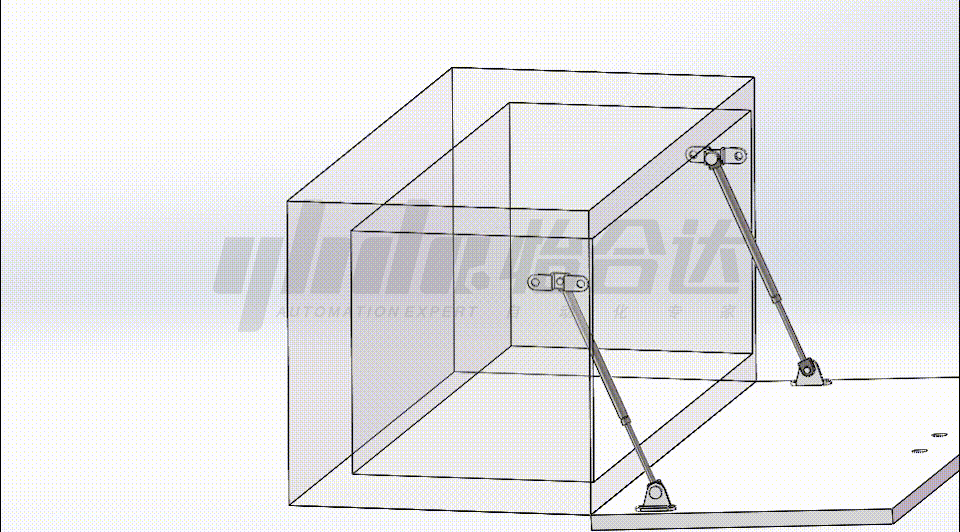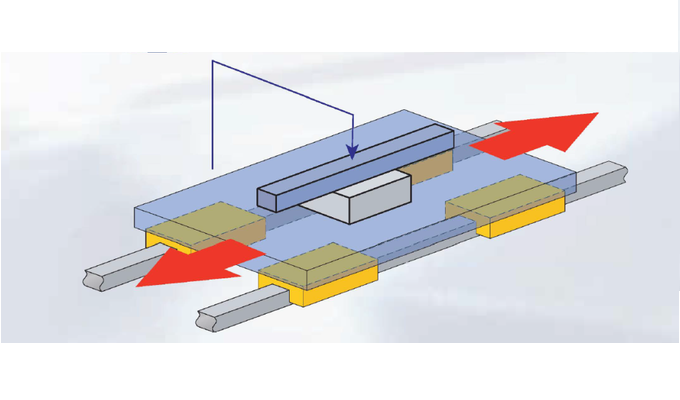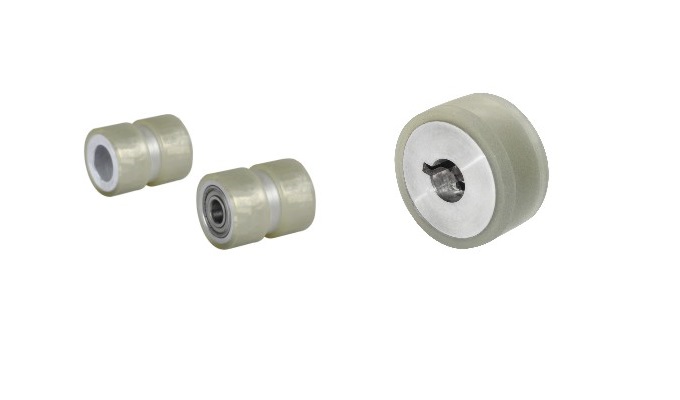Introduction of Nitrogen Gas Spring
Nitrogen Gas Spring, also known as gas strut or gas spring, operates by filling a sealed cylinder with high-pressure gas (nitrogen: non-combustible, non-toxic, and odorless) and utilizing the continuous reactive force of nitrogen as a spring.
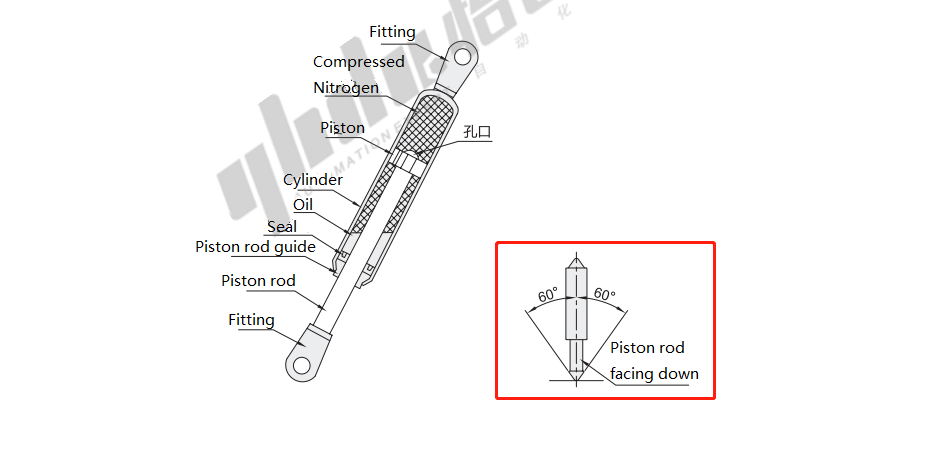
Working Principle: By maintaining equal pressure on both sides of the piston through a gas port, a pressure difference is created due to the difference in force-receiving area on both sides of the piston (one side has a reduced force-receiving area due to the cross-sectional area of the piston rod). This results in a sustained outward force. A small amount of oil is injected internally to provide lubrication, sealing, and damping. During the entire compression-extension motion, the gas spring also generates a certain amount of frictional force. Standard free-type gas springs have two damping stages, namely, pneumatic and hydraulic. When the piston rod is downward mounted and extends, the piston goes through the pneumatic stage first, followed by the hydraulic zone, resulting in a slow and flexible opening effect.

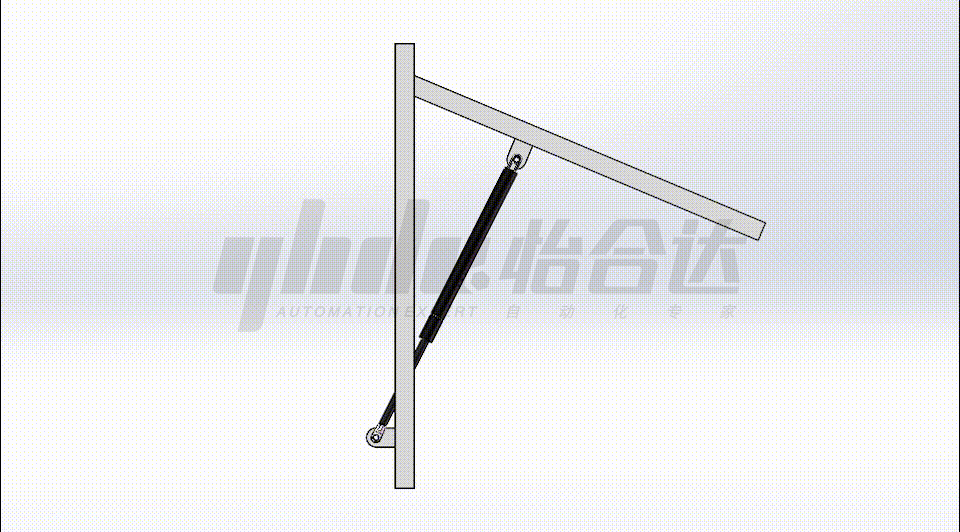
The Production Process of Nitrogen Gas Springs
1. Material Cutting: Cut or trim metal sheets or tubes from raw materials according to the design requirements.
2. Chamfering: Perform chamfering on the cut metal sheets or tubes to make the edges smooth and reduce sharpness.
3. Cleaning: Clean the metal materials to remove surface oil, dust, and other impurities, ensuring a clean surface.
4. Expanding: Expand one or both ends of the metal tube as required by the design for subsequent connections and installations.
5. Welding: Weld the expanded metal tube to form a cylinder and ensure its sealing.
6. Spin Riveting: Use spin riveting method during the production process to fasten some components together, enhancing the stability of the spring.
7. Assembly: Assemble the welded and fixed components, including installing pistons, piston rods, and other parts.
8. Sealing and Pressing Ribs: Perform rib pressing at the cylinder's sealing area to prevent nitrogen gas leakage.
9. Inflation Testing: Conduct inflation testing on the assembled nitrogen gas spring to check if the pressure and sealing performance meet the standards.
10. Painting: Depending on customer requirements or design needs, spray paint the nitrogen gas spring to provide a visually appealing surface and corrosion protection.
11. Baking Paint: Place the painted nitrogen gas spring in an oven for baking, ensuring the paint is cured and hardened.
12. Packaging: After passing quality inspection and confirming the correctness, package the finished nitrogen gas spring to ensure safety and integrity during transportation and storage.
Initial Force: Compared to traditional metal springs, nitrogen gas springs provide a relatively large reactive force at the starting compression position.
Stable Force Value: Throughout the entire stroke, the force of nitrogen gas springs remains relatively constant and does not significantly change during compression or extension.
Compact and Lightweight: Nitrogen gas springs are known for their small and lightweight design while still delivering substantial elastic force.
Versatile Design: Nitrogen gas springs offer various functionalities such as soft stop, free stop, controllable, compression, and tension types, catering to different application needs.
In the design of gas springs, the reactive force F1 is usually measured at a position 5mm (or sometimes 10mm) before the piston rod is fully extended. This is considered one of the most critical parameters, apart from the external dimensions, when calculating the reactive force.
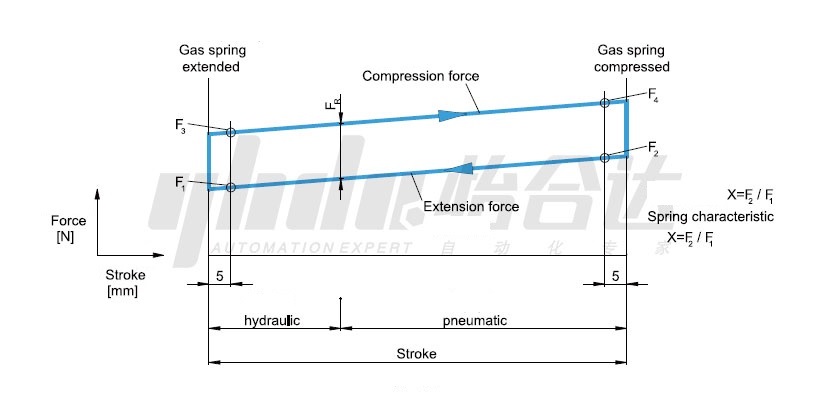
How to Select The Suitable Nitrogen Gas Spring?
1. Calculate the Reactive Force:

(1) If multiple (n) nitrogen gas springs are supporting the load, divide the calculated force by n.
(2) After calculation, it is recommended to reserve around 10% additional force, i.e., multiply the calculated force by n.
(3) The unit of calculation depends on the weight of the door: If the door weight is given in Newton (N), the force value will be in N; if the door weight is given in kilograms (kg), the force value will be in kg.
(4) The force value (F) may change due to the angle of the door and the installation position of the nitrogen gas spring. Consider the design structure as a basis, and if there are adjustments, recalculate the force values.
(5) The pivot installation position is crucial for ensuring the normal operation of the nitrogen gas spring. When the door is closed, the point of force application should pass through the center of the structure (refer to figure 3). Otherwise, the nitrogen gas spring may automatically push the door open.
2. Determine the Maximum Length of the Nitrogen Gas Spring:
Measure the farthest distance between the two mounting points of the nitrogen gas spring during its movement process.Choose a nitrogen gas spring with a maximum length (Lmax) greater than this measured distance.
3. Determine the Stroke of the Nitrogen Gas Spring:
Measure the farthest distance between the two mounting points of the nitrogen gas spring during its movement process and subtract the nearest distance from it. This difference is the stroke.
Select a nitrogen gas spring with a stroke greater than this difference, and ensure that the minimum length of the spring is less than the required length. Leave a 5-10mm stroke space.
4. Determine the Fixing Method of the Nitrogen Gas Spring Joint.
5. Based on the initial reactive force, maximum length, stroke, and joint fixing method, choose an appropriate specification and model from the nitrogen gas catalog.
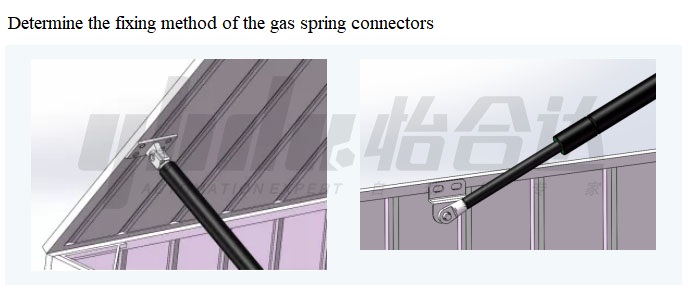
The Use Precautions of Nitrogen Gas Springs
Nitrogen gas springs are high-pressure products. It is strictly prohibited to dismantle, heat, strike, or collide with them to avoid accidents.
The piston rod of the nitrogen gas spring must be installed downward and should not be installed in reverse. This helps to reduce friction and ensure optimal damping quality and cushioning performance.
During operation, nitrogen gas springs should not be subjected to inclined or lateral forces, and they should not be used as handles or for other purposes to prevent bending or deformation of the product.
To ensure reliable sealing of the nitrogen gas spring, please avoid damaging the surface of the piston rod and never apply paint or chemicals on it, as this may affect its service life.
The recommended operating temperature for nitrogen gas springs is generally between -30°C and +80°C.
The installation connection points should allow for flexible rotation and should not exhibit any blocking or obstruction.
When selecting the size of the nitrogen gas spring, consider the appropriate force and leave a certain margin for the piston rod stroke.
How to Correctly Install Nitrogen Gas Springs
Temperature: The normal operating temperature range is -20°C to +60°C. Extreme temperatures (too high or too low) may cause the nitrogen gas spring to fail or leak. Additionally, the ambient temperature can affect the reactive force of the gas spring, with higher temperatures resulting in greater reactive force.
Avoidance of certain environments:
Dust: Dust can stick to the piston rod during movement, damaging the sealing structure and causing leaks. If used in dusty environments, consider adding dust-proof covers.
Corrosion: Corrosion on the piston rod can affect the internal sealing structure, leading to leakage and failure.
Paint: Do not paint the piston rod or apply any substances that may adhere to it. During the expansion and contraction process of the piston rod, such substances can pass through the sealing structure, compromising its sealing effectiveness and causing leaks.
Prevent scratches on the cylinder body and piston rod: Nitrogen gas springs rely on the internal sealing structure and the surface of the piston rod to achieve sealing. Avoid any collisions, compression, scratches, adhesives, entanglements, or rust on the piston rod surface, as this can damage the sealing and result in leaks or failures.
Avoid lateral forces on the nitrogen gas spring: Lateral forces on the gas spring can cause bending of the piston rod and deformation of the internal sealing structure, leading to malfunction, sticking, or gas leakage.
Do not exceed the stroke limit: When choosing a nitrogen gas spring, leave a 5-10 mm stroke space (e.g., if a 70mm stroke is required, choose an 80mm or larger stroke specification). The position of the gas spring joint, welding position, paint protection, or joint structure may cause collisions or contact with the sealing structure during expansion and contraction, resulting in gas leakage or failure.
Keep the joints at both ends of the nitrogen gas spring and the fixed bracket in a relative rotating state: During use, there may be relative rotation between the joint area and the fixed point of the equipment. If relative rotation is not achieved during installation, it may cause joint fractures.
Avoid deflection during installation: During installation, ensure that the motion plane of the nitrogen gas spring is in the same plane as the two end mounting points and that the joint's relative rotating plane is the same as the actual motion plane of the gas spring. Avoid tilting or deflection, as this can cause the gas spring to be subjected to lateral forces (see point 4), leading to gas leakage or joint fracture.
Install the nitrogen gas spring with the piston rod facing downward: Installing the piston rod facing downward ensures lubrication of the internal oil, sealing protection of the sealing ring, and cushioning effect. If installed facing upward for a long time, the sealing ring may experience prolonged dry friction with the piston rod, leading to gas leakage and failure.
Incorrect installation direction causing automatic door opening or too fast closing without cushioning: During the installation design, consider the direction of the reactive force of the nitrogen gas spring during the door closing process. Ensure there is no opening direction force after closing the door, and throughout the closing process, the reactive force continuously supports the door. Otherwise, it may result in the door springing open again after closing or the door closing too quickly.
Improper selection of nitrogen gas spring length or stroke: During the design and installation process, consider that a too short stroke or excessively long length may result in the door not being able to close completely.
Common FAQs of Nitrogen Gas Springs
Q: Why he threads of the nitrogen gas spring joint are prone to slippage, leading to assembly problems?
A: Usually, the joints and nitrogen gas springs are pre-assembled and tested before leaving the factory, so the threads of the joint themselves are not the issue. Slippage is mainly caused by customers not properly tightening the joints during use. Therefore, it is essential to ensure that the joints are tightened clockwise during subsequent assembly to avoid any assembly problems.
Q: Does the nitrogen gas spring have high-temperature resistance?
A: The recommended operating temperature range for nitrogen gas springs is -20°C to +60°C. Currently, there is no specific series designed for higher temperatures. However, if there is a need for high-temperature resistance with specific materials, customized designs can be considered to meet the requirements.
Q: What does "maximum length-10mm" and "maximum length-Smm" mean in the catalog?
A: "Maximum length-10mm" refers to the compression of the nitrogen gas spring by 10mm at its maximum length, and "maximum length-S" refers to the extension stroke of the nitrogen gas spring at its maximum length. These parameters are crucial in selecting the appropriate nitrogen gas spring model based on specific application needs.
More information you want to know more about nitrogen gas springs: Q&A: Nitrogen Gas Springs
Applications of Nitrogen Gas Spring
Automotive: Used for car trunk lids, doors, engine compartment covers, and other parts, providing convenient opening and closing functions.
Machinery: Suitable for various machinery equipment's covers, drawers, baffles, and other components, offering stable support and cushioning effects.
Furniture Industry: Applied to furniture storage cabinets, under-bed storage boxes, and other components, making furniture opening and closing smoother and easier.
Printing Machinery: Used in printing machines for plate sliders, workbenches, and other parts, achieving smooth motion and positioning.
Medical Equipment: Suitable for medical equipment's adjustable beds, operating tables, and other components, providing precise height adjustment and support.
Fitness Equipment: Applied to fitness equipment's adjustable seats, cushions, and other parts, making adjustments more flexible and convenient.
Mold Equipment: Used in mold equipment for mold opening, closing, and demolding actions, providing precise control and support.
Application Cases of Gas Springs
Application Case: Loading Cart with Nitrogen Gas Springs
Equipment Name: Loading Cart
Design Purpose: Facilitate the loading and unloading of goods
Part Application Description: When goods are placed on the cart, the weight of the goods causes the clamping board to close. When the goods are removed, the nitrogen gas springs lift the clamping board, making it easier to insert the forks for the next layer of goods. During this process, the nitrogen gas springs provide a cushioning and rebound effect, ensuring the smooth opening and closing of the clamping board on the cart.

Horizontal Opening:
The nitrogen gas spring is used to facilitate the horizontal opening of a specific device or component. When activated, the gas spring provides the necessary force to smoothly and effortlessly open the device horizontally.
Side Opening Upwards:
In this application, the nitrogen gas spring is utilized to enable the side opening of a particular object or mechanism. When triggered, the gas spring exerts force to allow the side of the object to open upwards, providing easy access to the contents or functionalities of the object. The gas spring also ensures controlled and safe motion during the opening process.

Opening Downwards from the Side:
In this scenario, the nitrogen gas spring is used to enable the side of the object to open downwards. When activated, the gas spring provides the necessary force to lower the side of the object, allowing easy access to its contents or functionalities. The gas spring ensures controlled and safe motion during the opening process.
